Functional Identification and Genetic Transformation of the Ammonium Transporter PtrAMT1;6 in Populus
Abstract
:1. Introduction
2. Results
2.1. Expression Pattern of the P. trichocarpa Ammonium Transporter
2.2. Multiple Alignment and Transmembrane Domain Prediction of the N-Terminal Sequence of the AMT1 Protein Family in Populus Trichocarpa and Solanum lycopersicum L.
2.3. Yeast Complementary Function
2.4. Arabidopsis GUS Staining
2.4.1. Promoter Component Analysis
2.4.2. Expression of PtrAMT1;6P::GUS in Arabidopsis
2.5. Overexpression of PtrAMT1;6 in Populus alba × P. glandulosa cv. ‘84K’
2.5.1. PtrAMT1;6 Gene Expression Detection
2.5.2. Growth Phenotype of Outdoor Potted ‘84K’ poplar
2.5.3. Photosynthetic Parameters
2.5.4. Total Carbon and Nitrogen Content and Carbon-to-Nitrogen Ratio
2.5.5. Soluble Protein and Soluble Sugar Content
2.5.6. Glutamine Synthetase Content
2.5.7. Free Amino Acid Content
2.5.8. Relative Expression Levels of the Ammonium Transporter and Nitrate Transporter Genes
2.5.9. Relative Expression Level of the Glutamine Synthetase Gene
2.5.10. Relative Expression Levels of the Nitrate Reductase and Nitrite Reductase Genes
3. Discussion
4. Materials and Methods
4.1. Plant Materials
4.2. Strains, Vectors, and Reagents
4.3. Sample Treatment for the Expression Pattern Analysis of the P. trichocarpa Ammonium Transporter Protein PtrAMT1;6
4.4. Expression Pattern Analysis of Ammonium P. trichocarpa Transporter Protein PtrAMT1;6 Sample Treatment
4.5. Cloning of the PtrAMT1;6 Gene and Construction of pEASY- PtrAMT1;6 in P. trichocarpa
4.6. pYES2-AMT1;6 Vector Construction and Functional Complementation in Yeast
4.7. PtrAMT1;6P::GUS Construction and Expression in Arabidopsis
4.7.1. Promoter Element Analysis
4.7.2. Cloning and Expression Vector Construction of the PtrAMT1;6 Promoter in Populus Tridentata
4.7.3. Construction of the Genetic Transformation System and GUS Staining in Arabidopsis
4.8. Determination of Genetic Transformation and Physiological Data of the ‘84K’ Poplar PtrAMT1;6 Gene
4.8.1. Carrier Construction
4.8.2. Construction of ‘84K’ poplar PtrAMT1;6 Gene Overexpression and Repressed Expression Strains
4.8.3. Physiological Index Measurement
5. Conclusions
Supplementary Materials
Author Contributions
Funding
Informed Consent Statement
Data Availability Statement
Acknowledgments
Conflicts of Interest
References
- Lanquar, V.; Frommer, W.B. Adjusting ammonium uptake via phosphorylation. Plant Signal. Behav. 2010, 5, 736–738. [Google Scholar] [CrossRef] [PubMed]
- Zhou, Y.; Bai, L.; Song, C.-P. Ammonium homeostasis and signaling in plant cells. Sci. Bull. 2015, 60, 741–747. [Google Scholar] [CrossRef]
- Stewart, W.M.; Dibb, D.W.; Johnston, A.E.; Smyth, T.J. The Contribution of Commercial Fertilizer Nutrients to Food Production. Agron. J. 2005, 97, 1–6. [Google Scholar] [CrossRef]
- Chen, Y.-F.; Wang, Y.; Wu, W.-H. Membrane transporters for nitrogen, phosphate and potassium uptake in plants. J. Integr. Plant Biol. 2008, 50, 835–848. [Google Scholar] [CrossRef]
- Couturier, J.; Montanini, B.; Martin, F.; Brun, A.; Blaudez, D.; Chalot, M. The expanded family of ammonium transporters in the perennial poplar plant. New Phytol. 2007, 174, 137–150. [Google Scholar] [CrossRef]
- Gazzarrini, S.; Lejay, L.; Gojon, A.; Ninnemann, O.; Frommer, W.; von Wirén, N. Three Functional Transporters for Constitutive, Diurnally Regulated, and Starvation-Induced Uptake of Ammonium into Arabidopsis Roots. Plant Cell 1999, 11, 937–947. [Google Scholar] [CrossRef]
- Cooper, A.J.L.; Plum, F. Biochemistry and physiology of brain ammonia. Physiol. Rev. 1987, 67 2, 440–519. [Google Scholar] [CrossRef]
- Britto, D.T.; Kronzucker, H.J. NH4+ toxicity in higher plants: A critical review. J. Plant Physiol. 2002, 159, 567–584. [Google Scholar] [CrossRef]
- Schäfer, A. Characterization of Ammoniumtransporters in Arabidopsis Thaliana; Universität Potsdam: Potsdam, Germany, 2005. [Google Scholar]
- Rawat, S.R.; Silim, S.N.; Kronzucker, H.J.; Siddiqi, M.Y.; Glass, A.D.M. AtAMT1 gene expression and NH4+ uptake in roots of Arabidopsis thaliana: Evidence for regulation by root glutamine levels. Plant J. Cell Mol. Biol. 1999, 19, 143–152. [Google Scholar] [CrossRef]
- Yuan, L.; Gu, R.; Xuan, Y.; Smith-Valle, E.; Loqué, D.; Frommer, W.B.; von Wirén, N. Allosteric Regulation of Transport Activity by Heterotrimerization of Arabidopsis Ammonium Transporter Complexes in vivo. Plant Cell 2013, 25, 974–984. [Google Scholar] [CrossRef]
- Lima, J.E.; Kojima, S.; Takahashi, H.; von Wirén, N. Ammonium Triggers Lateral Root Branching in Arabidopsis in an Ammonium Transporter1;3-Dependent Manner. Plant Cell 2010, 22, 3621–3633. [Google Scholar] [CrossRef] [PubMed]
- Sonoda, Y.; Ikeda, A.; Saiki, S.; Yamaya, T.; Yamaguchi, J. Feedback regulation of the ammonium transporter gene family AMT1 by glutamine in rice. Plant Cell Physiol. 2003, 44, 1396–1402. [Google Scholar] [CrossRef] [PubMed]
- Von Wirén, N.; Gazzarrini, S.; Gojon, A.; Frommer, W.B. The molecular physiology of ammonium uptake and retrieval. Curr. Opin. Plant Biol. 2000, 3, 254–261. [Google Scholar] [CrossRef] [PubMed]
- Von Wirén, N.; Lauter, F.-R.; Ninnemann, O.; Gillissen, B.; Walch-Liu, P.; Engels, C.; Jost, W.; Frommer, W.B. Differential regulation of three functional ammonium transporter genes by nitrogen in root hairs and by light in leaves of tomato. Plant J. Cell Mol. Biol. 2000, 21, 167–175. [Google Scholar] [CrossRef] [PubMed]
- Lam, H.M.; Coschigano, K.; Schultz, C.; Melo-Oliveira, R.; Tjaden, G.; Oliveira, I.; Ngai, N.; Hsieh, M.H.; Coruzzi, G. Use of Arabidopsis mutants and genes to study amide amino acid biosynthesis. Plant Cell 1995, 7, 887–898. [Google Scholar] [CrossRef]
- Melo-Oliveira, R.; Oliveira, I.C.; Coruzzi, G.M. Arabidopsis mutant analysis and gene regulation define a nonredundant role for glutamate dehydrogenase in nitrogen assimilation. Proc. Natl. Acad. Sci. USA 1996, 93, 4718–4723. [Google Scholar] [CrossRef]
- Wu, X.; Yang, H.; Qu, C.; Xu, Z.; Li, W.; Hao, B.; Yang, C.; Sun, G.; Liu, G. Sequence and expression analysis of the AMT gene family in poplar. Front. Plant Sci. 2015, 6, 337. [Google Scholar] [CrossRef]
- Graff, L.; Obrdlik, P.; Yuan, L.; Loqué, D.; Frommer, W.B.; von Wirén, N. N-terminal cysteines affect oligomer stability of the allosterically regulated ammonium transporter LeAMT1;1. J. Exp. Bot. 2011, 62, 1361–1373. [Google Scholar] [CrossRef]
- Marini, A.M.; Vissers, S.; Urrestarazu, A.; André, B. Cloning and expression of the MEP1 gene encoding an ammonium transporter in Saccharomyces cerevisiae. Embo J. 1994, 13, 3456–3463. [Google Scholar] [CrossRef]
- Ninnemann, O.; Jauniaux, J.C.; Frommer, W. Identification of a high affinity NH4+ transporter from plants. Embo J. 1994, 13, 3464–3471. [Google Scholar] [CrossRef]
- Shelden, M.C.; Dong, B.; De Bruxelles, G.L.; Trevaskis, B.; Whelan, J.; Ryan, P.R.; Howitt, S.M.; Udvardi, M.K. Arabidopsis ammonium transporters, AtAMT1;1 and AtAMT1;2, have different biochemical properties and functional roles. Plant Soil 2004, 231, 151–160. [Google Scholar] [CrossRef]
- Wang, Y.; Xuan, Y.; Wang, S.; Fan, D.; Wang, X.; Zheng, X. Genome-wide Identification, Characterization and Expression Analysis of the Ammonium Transporter Gene Family in Tea Plants (Camellia sinensis L.). Physiol. Plant. 2022, 174, e13646. [Google Scholar] [CrossRef] [PubMed]
- You, S.; Wang, Y.; Li, Y.; Li, Y.; Tan, P.; Wu, Z.; Shi, W.; Song, Z. Cloning and Functional Determination of Ammonium Transporter PpeAMT3;4 in Peach. Biomed Res. Int. 2020, 2020, 1–7. [Google Scholar] [CrossRef] [PubMed]
- Chen, M.; Zhu, K.; Xie, J.; Liu, J.; Tan, P.; Peng, F. Genome-Wide Identification and Expression Analysis of AMT and NRT Gene Family in Pecan (Carya illinoinensis) Seedlings Revealed a Preference for NH4+-N. Int. J. Mol. Sci. 2022, 23, 13314. [Google Scholar] [CrossRef]
- Hoque, M.S.; Masle, J.; Udvardi, M.; Ryan, P.R.; Upadhyaya, N.M. Over-expression of the rice OsAMT1-1 gene increases ammonium uptake and content, but impairs growth and development of plants under high ammonium nutrition. Funct. Plant Biol. Fpb 2006, 33, 153–163. [Google Scholar] [CrossRef]
- Ludewig, U.; Neuhäuser, B.; Dynowski, M. Molecular mechanisms of ammonium transport and accumulation in plants. Febs Lett. 2007, 581, 2301–2308. [Google Scholar] [CrossRef]
- Lea, P.J.; Miflin, B.J. Nitrogen Assimilation and its Relevance to Crop Improvement. Annu. Plant Rev. 2010, 42, 1–40. [Google Scholar] [CrossRef]
- Ruwandeepika, H.; Jayaweera, T.; Bhowmick, P.P.; Karunasagar, I.; Bossier, P.; Defoirdt, T. Genome-wide identification and expression analysis of ammonium transporter 1 (AMT1) gene family in cassava (Manihot esculenta Crantz) and functional analysis of MeAMT1;1 in transgenic Arabidopsis. 3 Biotech 2021, 4, 12. [Google Scholar] [CrossRef]
- Bao, A.; Liang, Z.; Zhao, Z.; Cai, H. Overexpressing of OsAMT1-3, a High Affinity Ammonium Transporter Gene, Modifies Rice Growth and Carbon-Nitrogen Metabolic Status. Int. J. Mol. Sci. 2015, 16, 9037–9063. [Google Scholar] [CrossRef]
- Otori, K.; Tanabe, N.; Maruyama, T.; Sato, S.; Yanagisawa, S.; Tamoi, M.; Shigeoka, S. Enhanced photosynthetic capacity increases nitrogen metabolism through the coordinated regulation of carbon and nitrogen assimilation in Arabidopsis thaliana. J. Plant Res. 2017, 130, 909–927. [Google Scholar] [CrossRef]
- Li, W.; Feng, Z.; Zhang, C. Ammonium transporter PsAMT1.2 from Populus simonii functions in nitrogen uptake and salt resistance. Tree Physiol. 2021, 41, 2392–2408. [Google Scholar] [CrossRef] [PubMed]

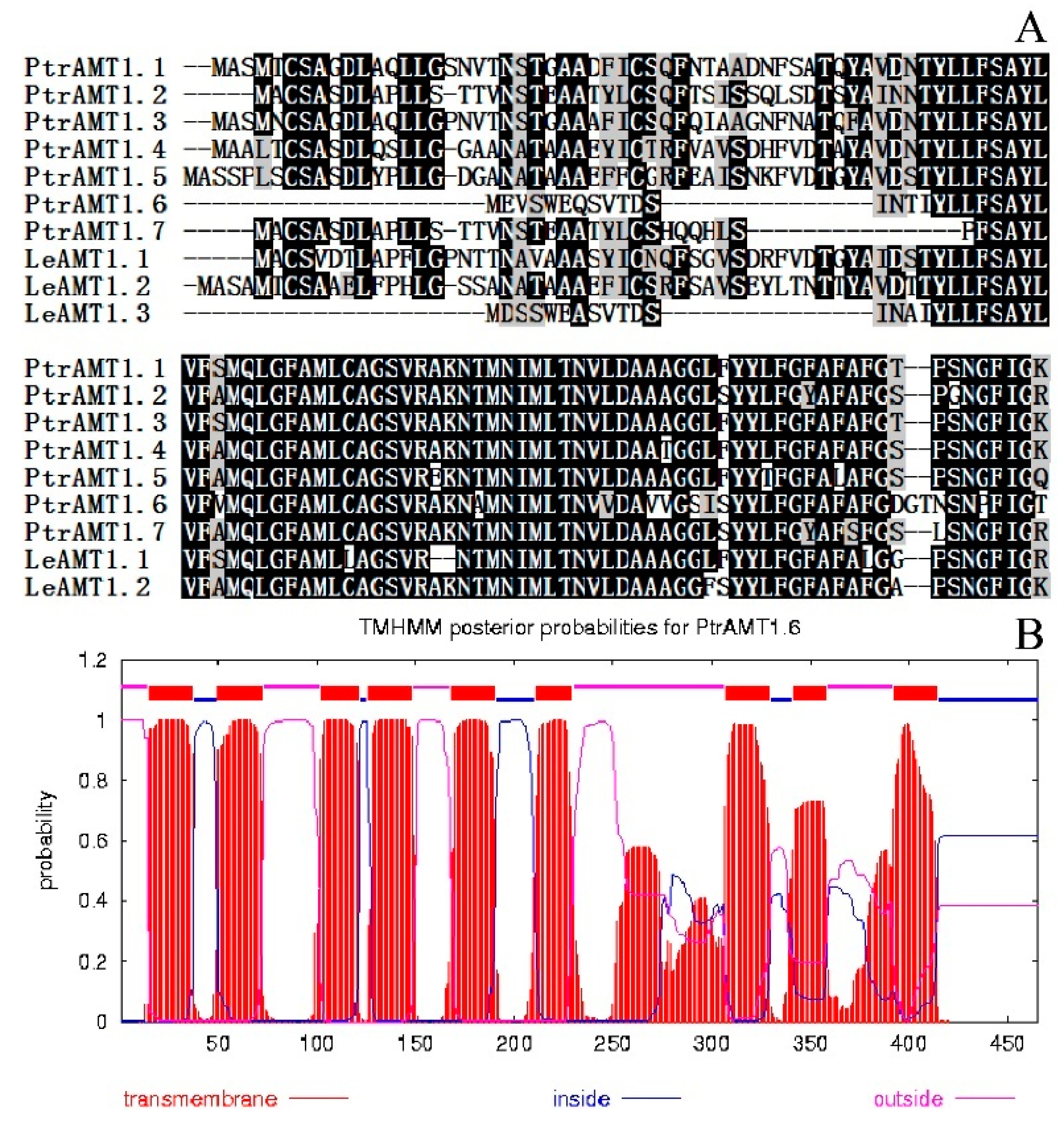
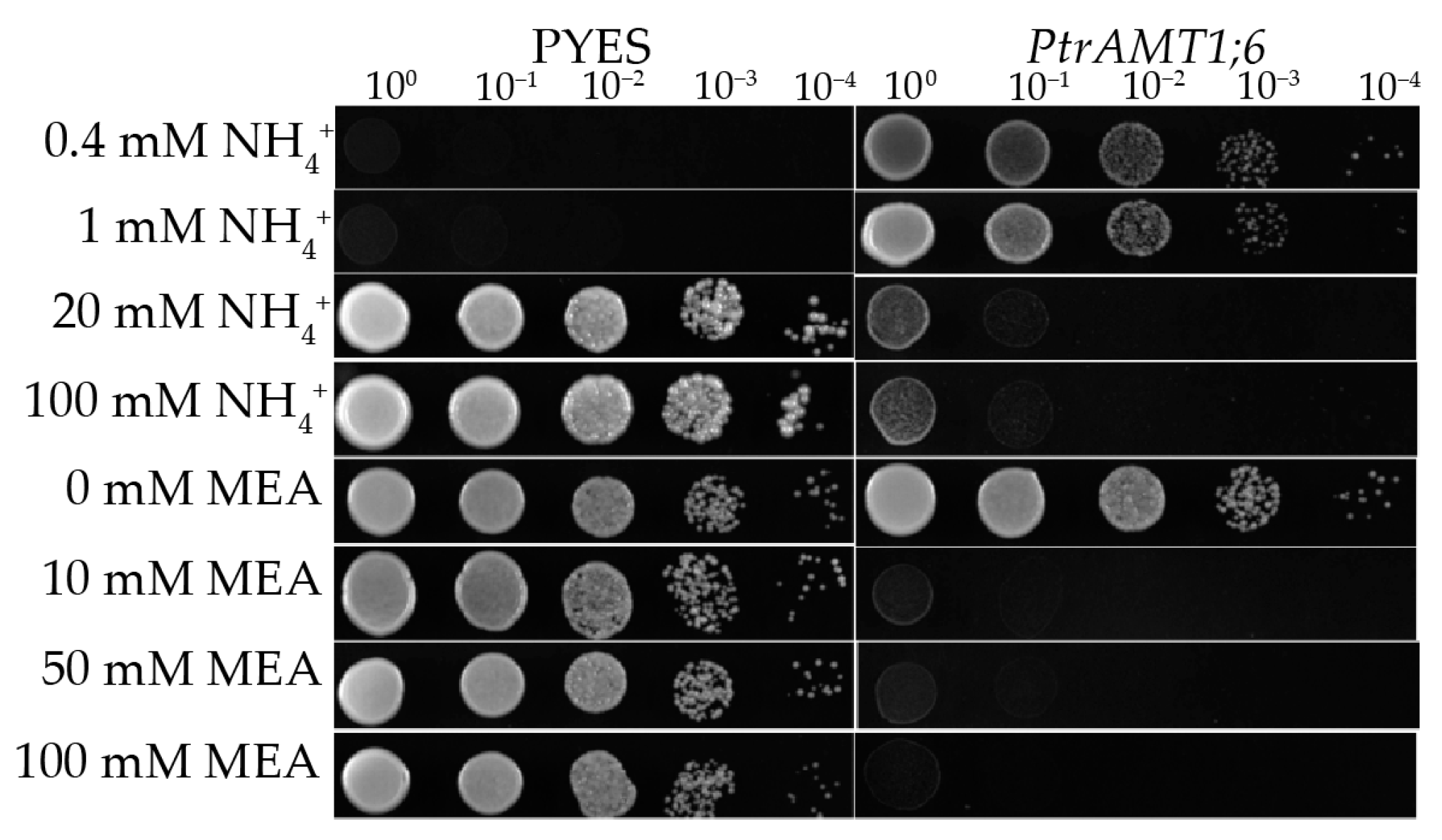
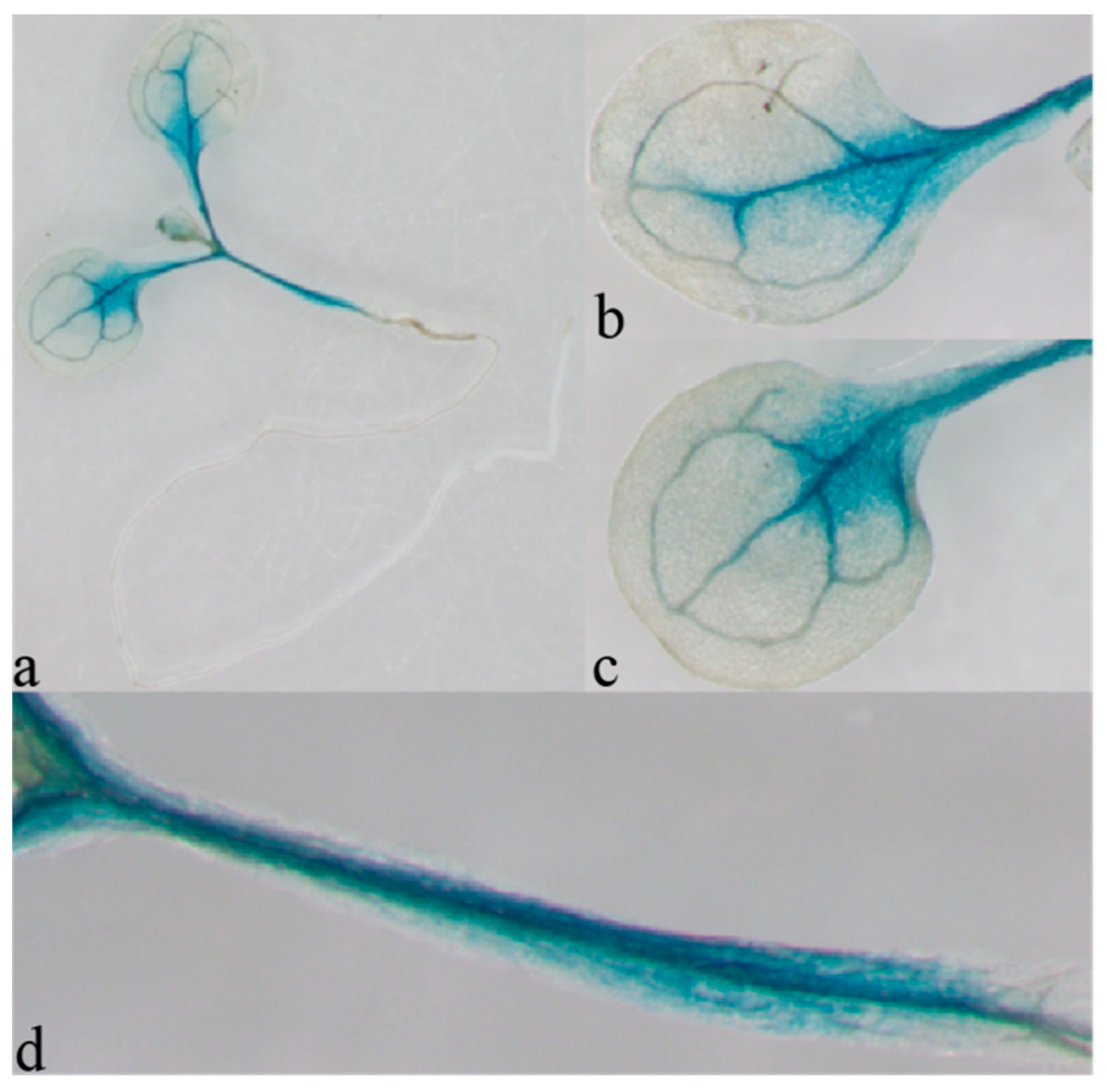
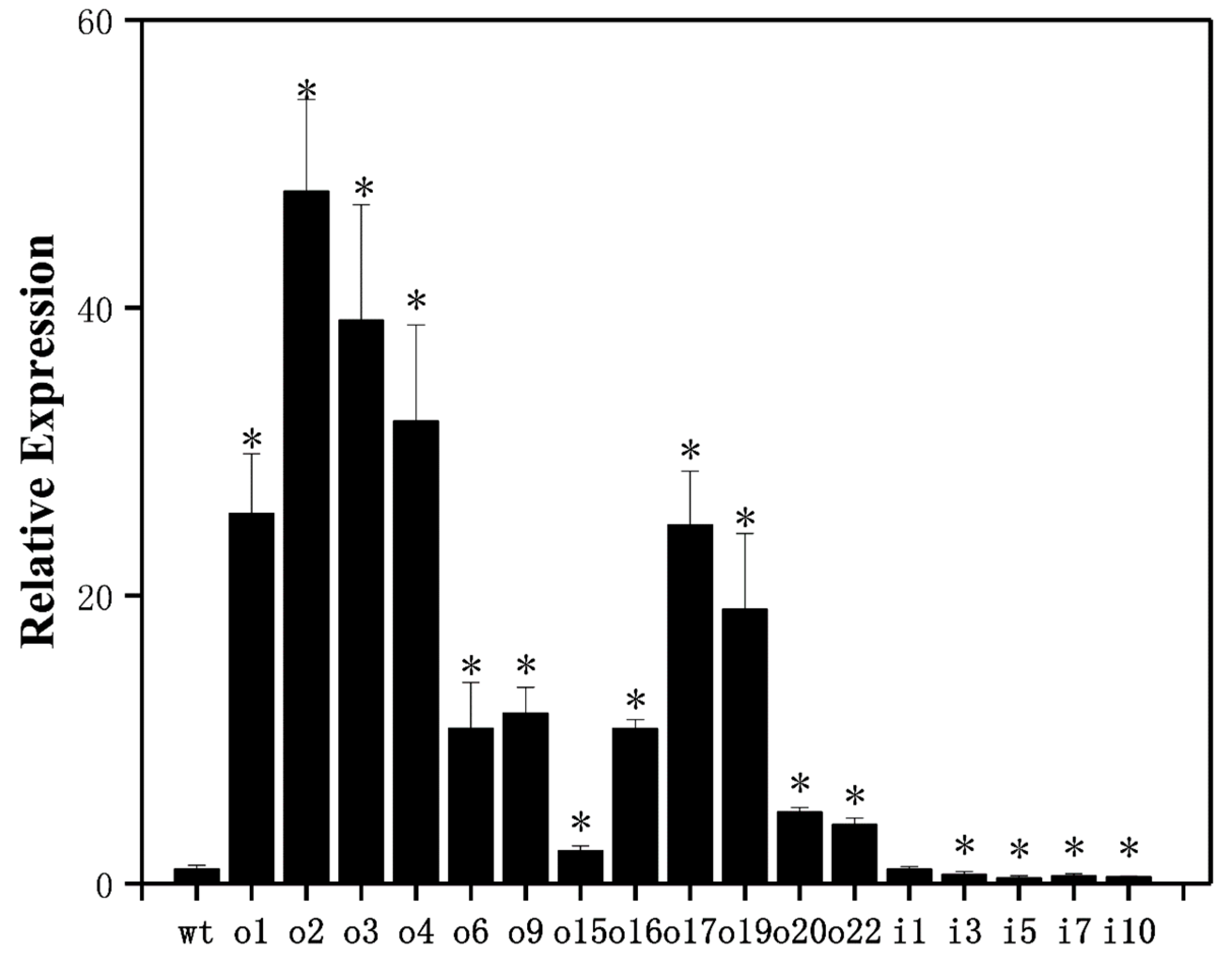
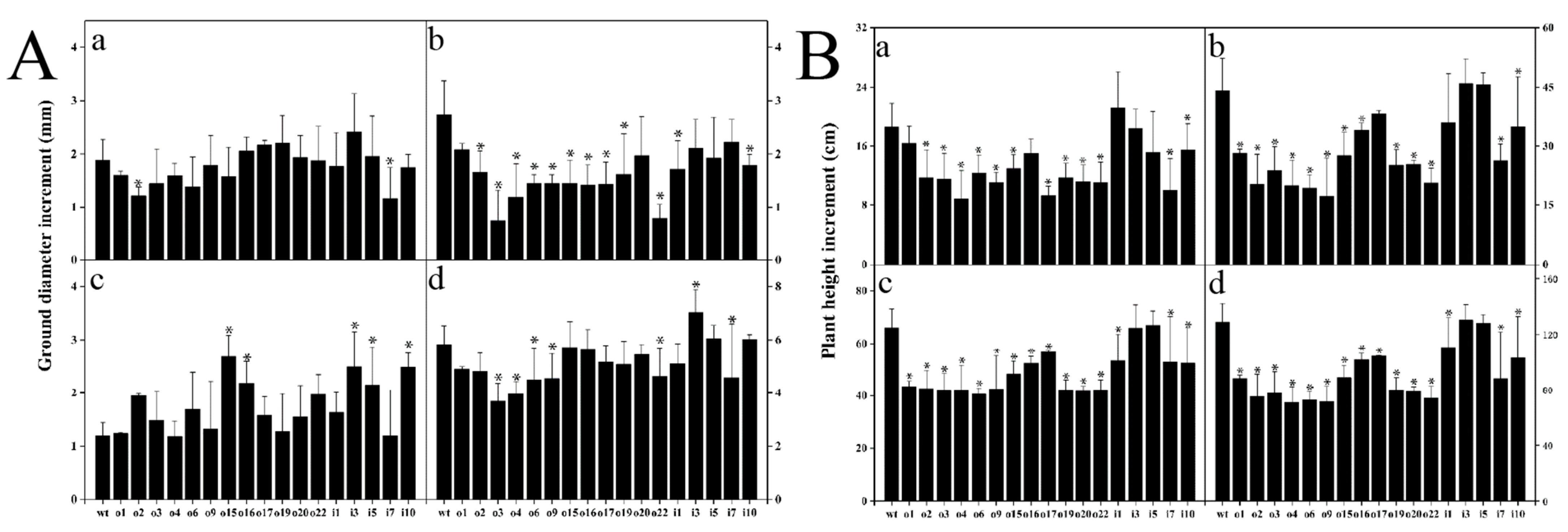

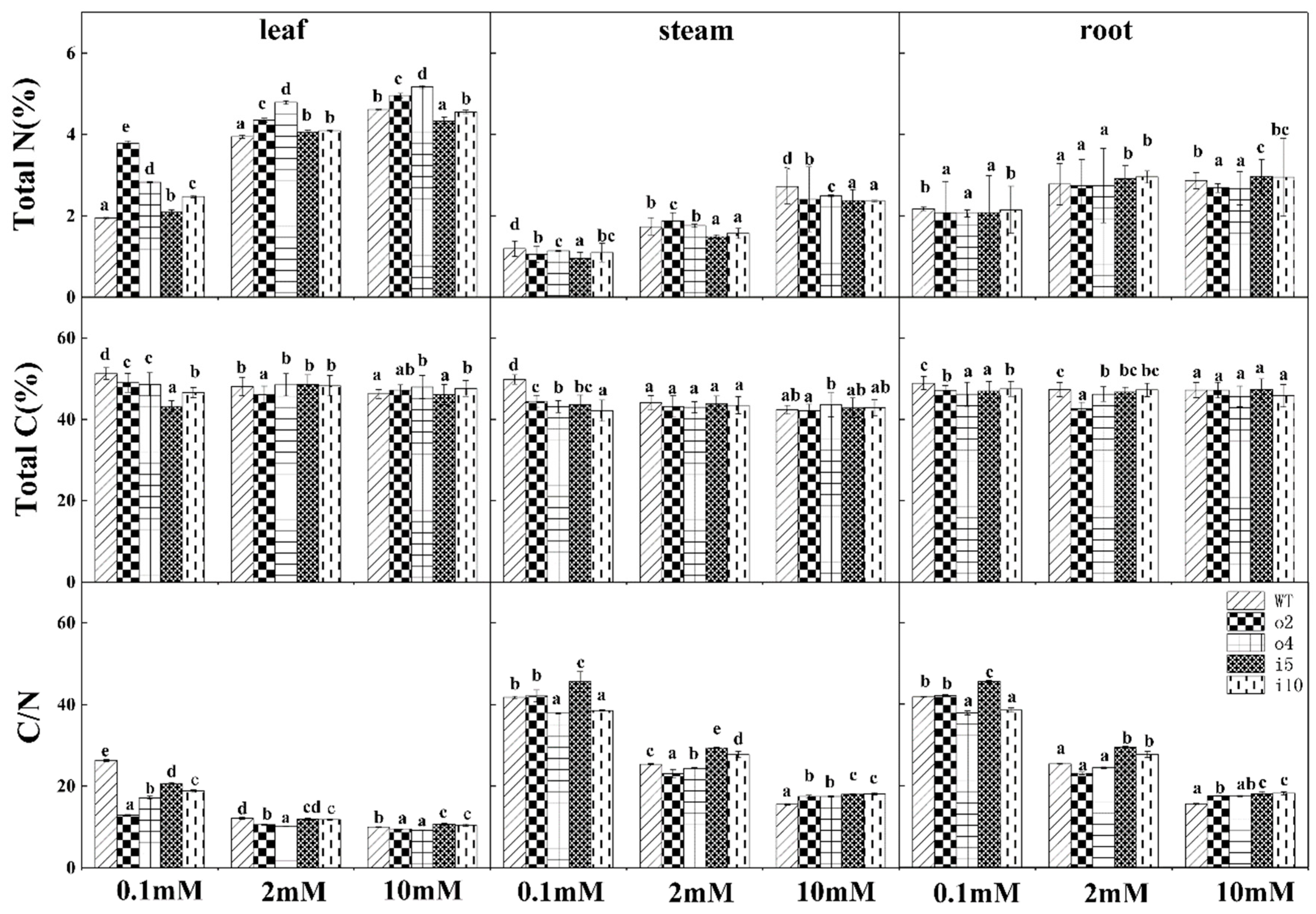
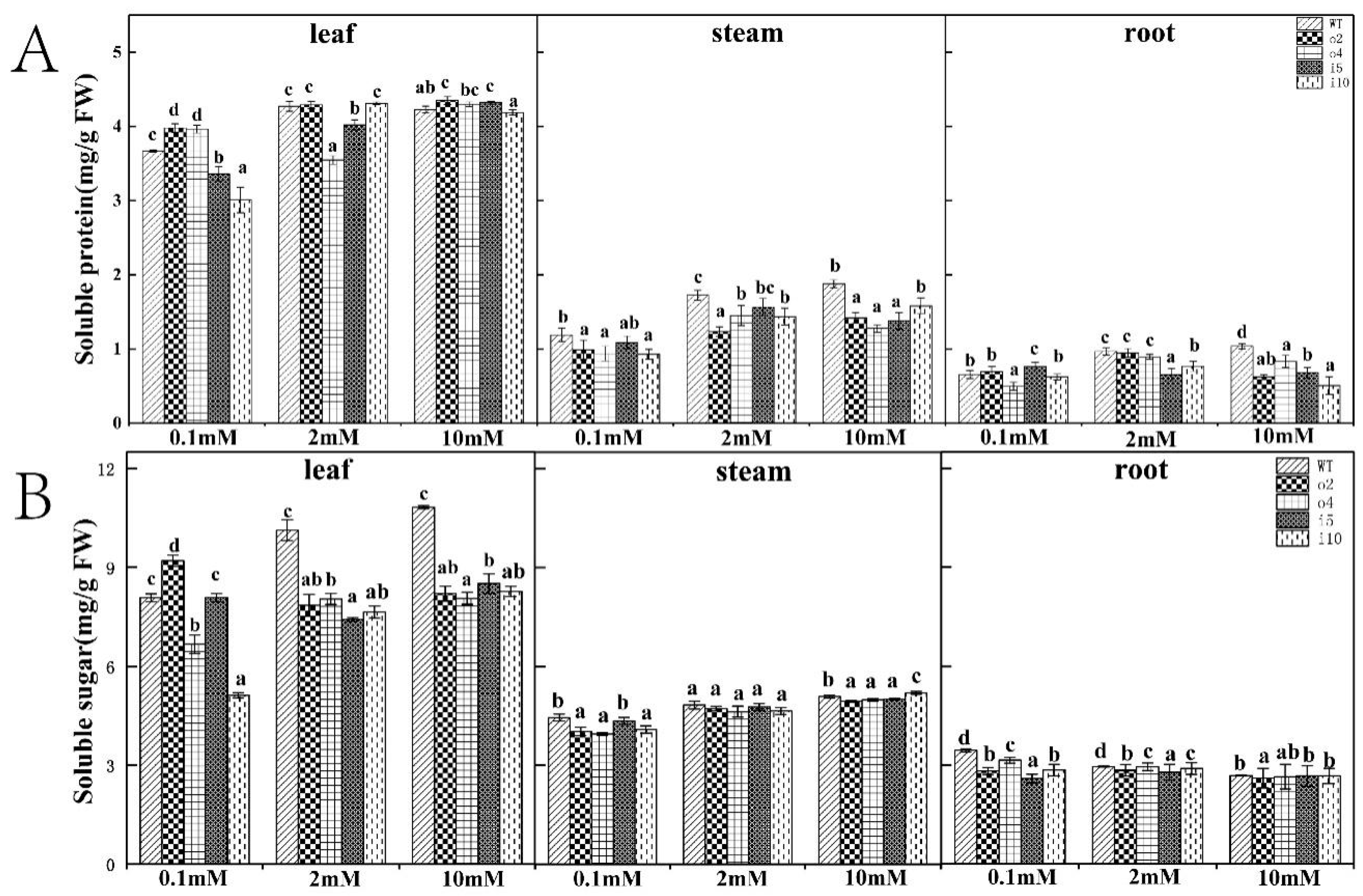

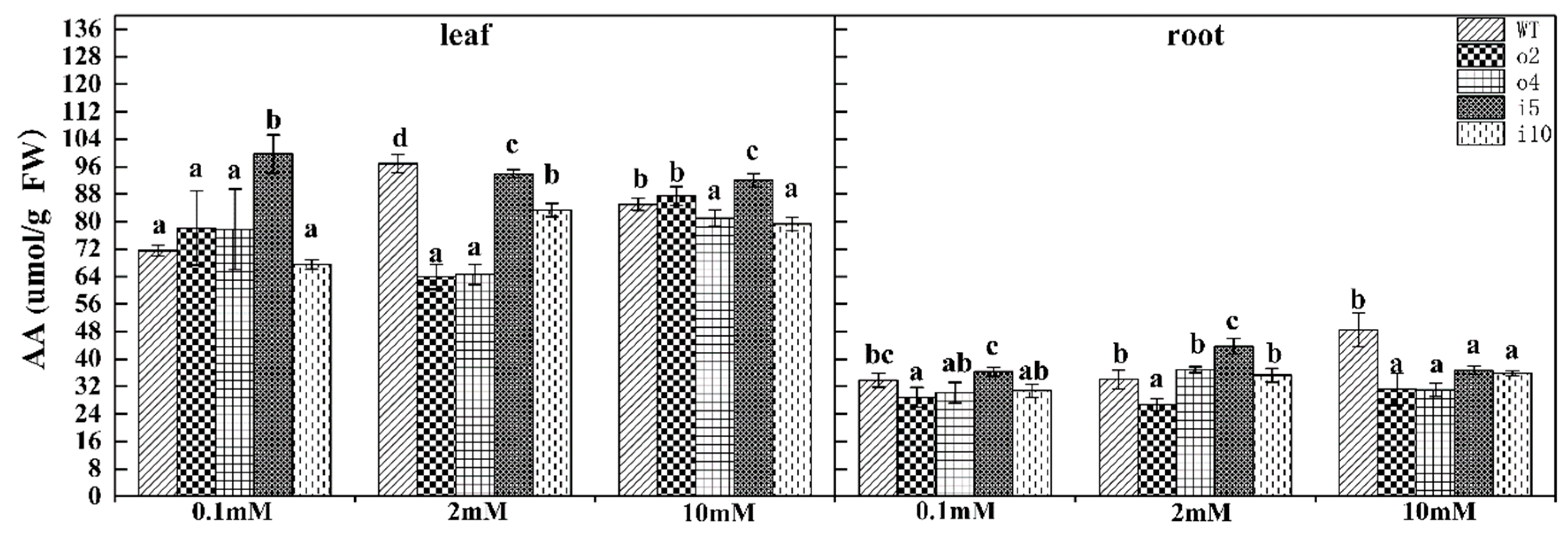
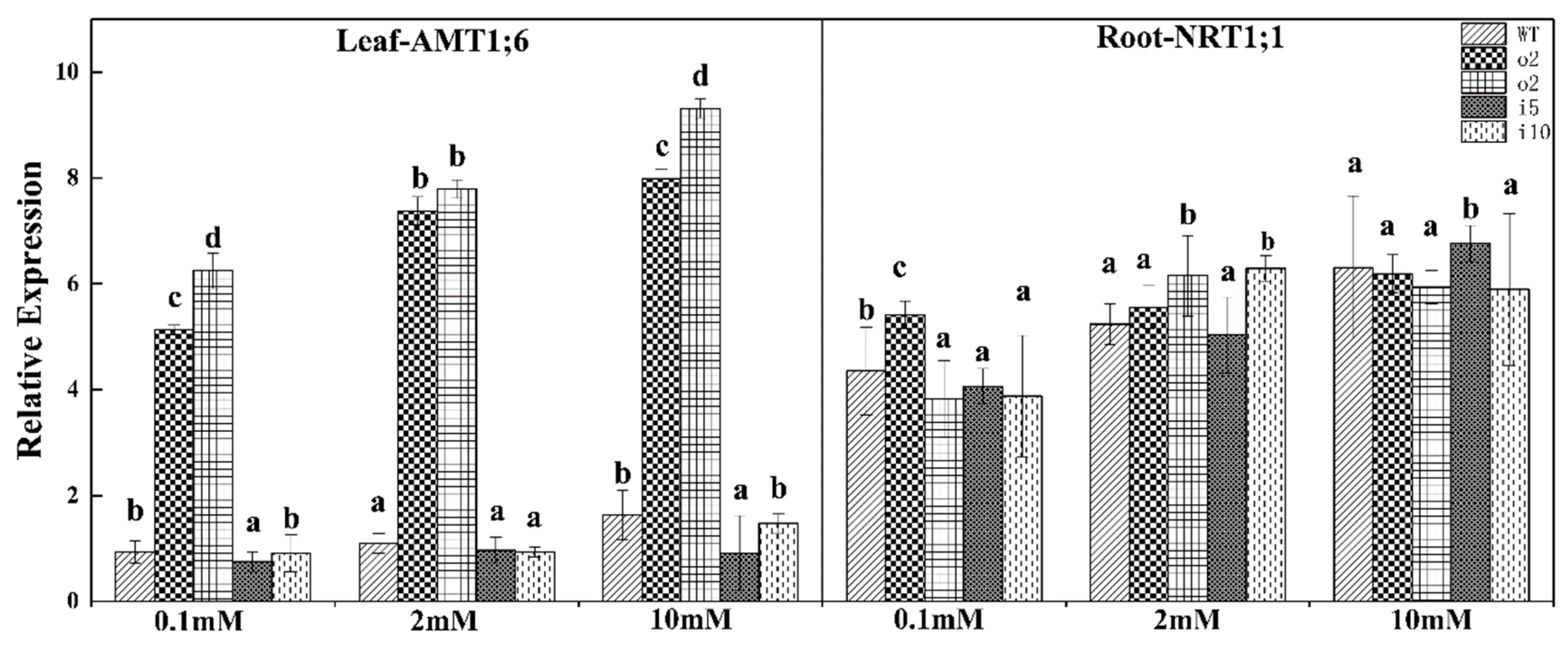

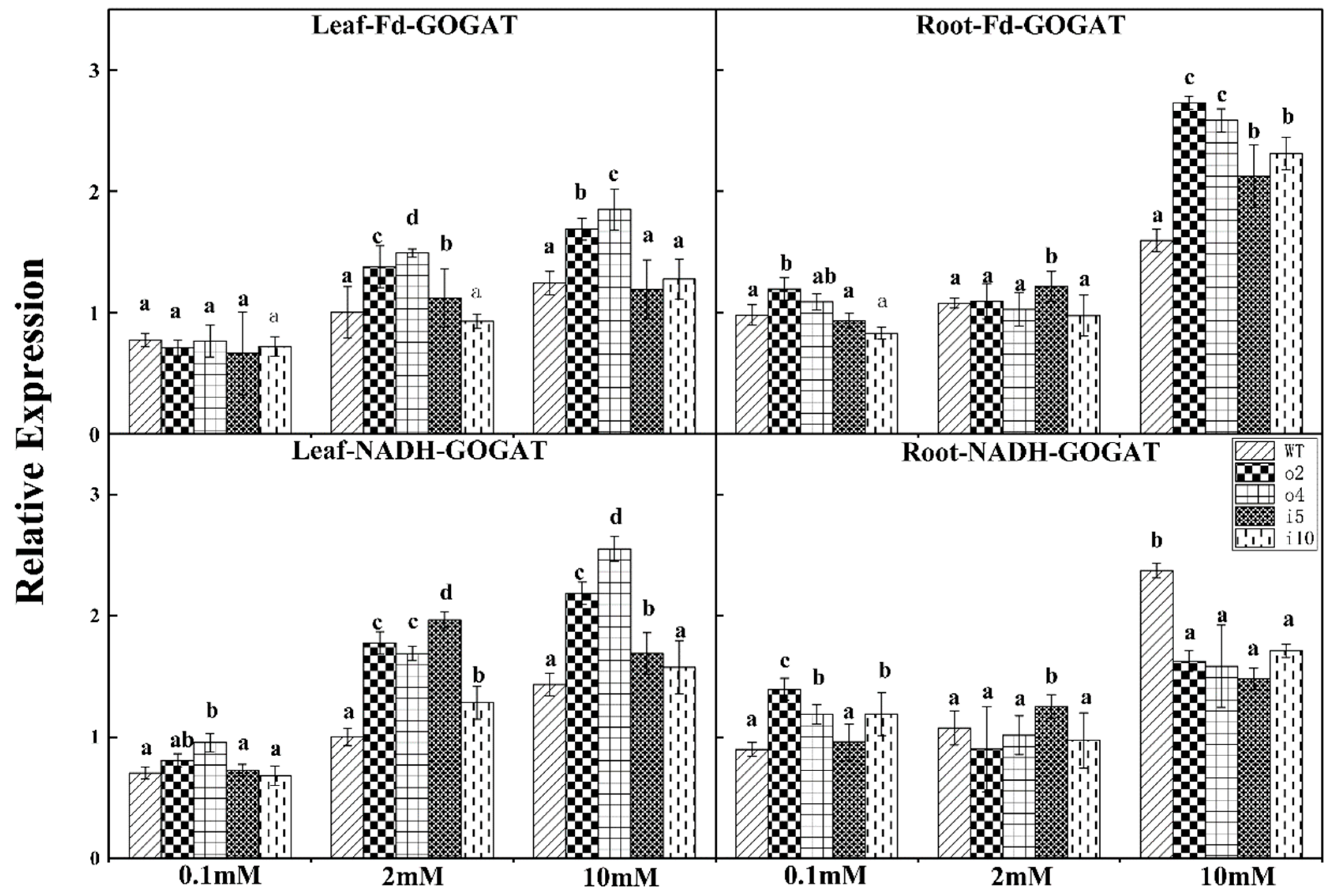
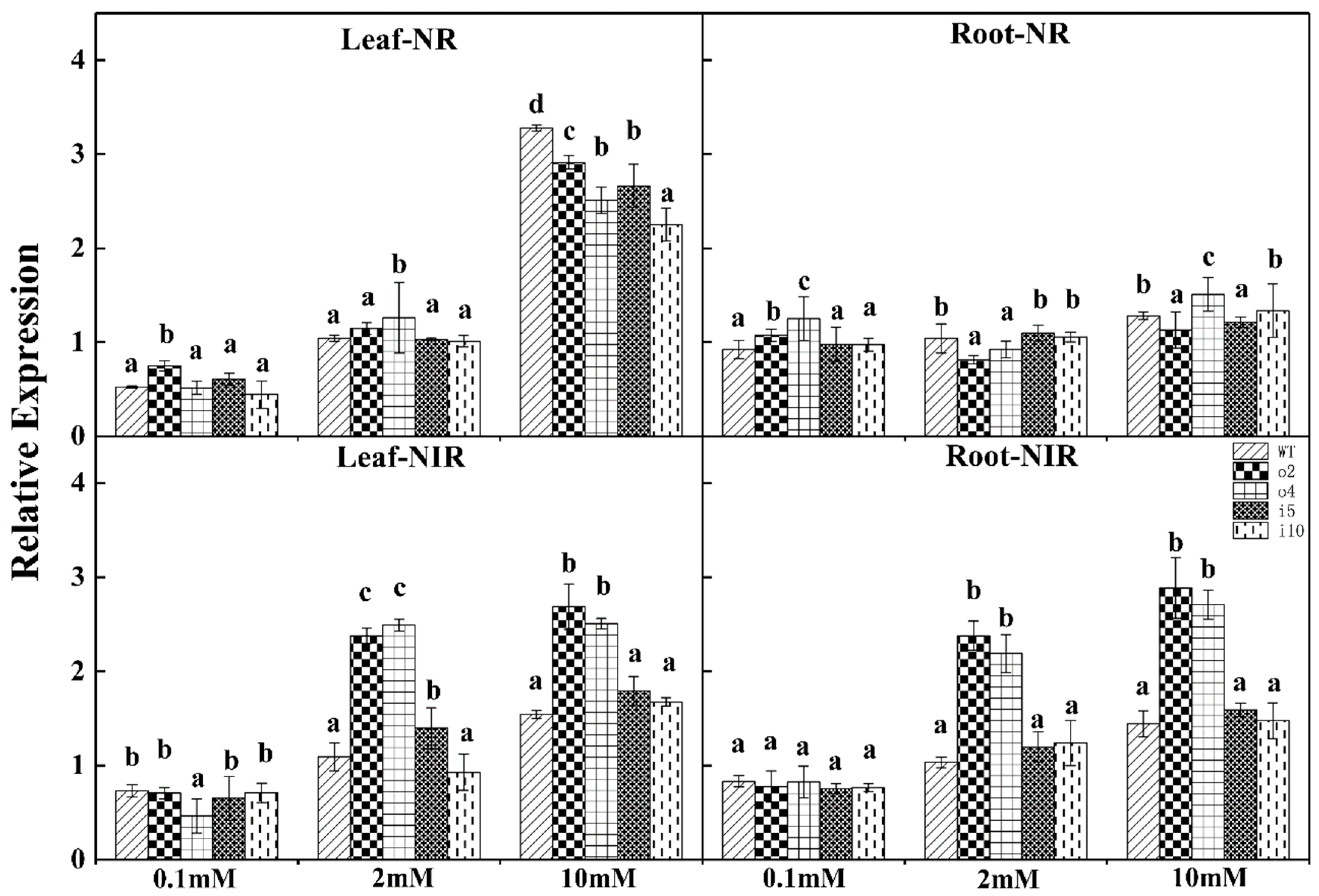
| Name | Position | Strand | Function |
|---|---|---|---|
| G-box | 417 | − | Light-responsive element |
| ATCT-motif | 1069 | + | Light-responsive element |
| Box 4 | 592 | + | Light-responsive element |
| CATT-motif | 691 | − | Light-responsive element |
| CG-motif | 602 | + | Light-responsive element |
| GA-motif | 247 | − | Light-responsive element |
| Box I | 9 | − | Light-responsive element |
| Box I | 540 | − | Light-responsive element |
| Sp1 | 859 | − | Light-responsive element |
| ERE | 540 | − | Ethylene-responsive element |
| circadian | 804 | + | Circadian control |
| circadian | 976 | + | Circadian control |
| ARE | 902 | − | Anaerobic induction |
| ARE | 1192 | + | Anaerobic induction |
| Strain | SPAD | Photosynthetic Rate (μmol CO2·m−2·s−2) | Stomatal Conductance (mmol·m−2·s−1) | Intercellular Carbon Dioxide Concentration (μL·L−1) | Transpiration Rate (mmol H2O·m−2·s−1) |
|---|---|---|---|---|---|
| wt | 12.5 ± 0.1 | 11.28 ± 1.83 | 0.66 ± 0.07 | 179.8 ± 38.55 | 4.34 ± 0.45 |
| O1 | 8.97 ± 0.12 *1 | 9.36 ± 0.76 | 0.66 ± 0.03 | 156.7 ± 27.95 * | 5.26 ± 0.14 |
| O2 | 8.47 ± 0.06 * | 8.68 ± 1.82 * | 0.71 ± 0.08 | 159.7 ± 40.77 * | 5.56 ± 0.55 * |
| O3 | 8.1 ± 0.06 * | 8.63 ± 1.59 * | 0.66 ± 0.06 | 173.4 ± 13.55 | 5.15 ± 0.38 |
| O4 | 9.57 ± 0.15 * | 10.2 ± 0.97 | 0.75 ± 0.05 | 146.2 ± 13.77 * | 5.9 ± 0.31 * |
| O6 | 8.6 ± 0.12 * | 8.27 ± 2.13 * | 0.59 ± 0.04 | 173.7 ± 36.26 | 4.92 ± 0.31 |
| O9 | 9.57 ± 0.37 * | 8.6 ± 1.31 * | 0.71 ± 0.05 | 168.5 ± 23.29 | 5.66 ± 0.34 * |
| O15 | 9.77 ± 0.07 * | 11.18 ± 1.75 | 0.73 ± 0.06 | 150.49 ± 9.39 * | 5.7 ± 0.5 * |
| O16 | 7.37 ± 0.1 * | 7.71 ± 1.11 * | 0.68 ± 0.04 | 213.8 ± 26.56 | 2.91 ± 0.18 * |
| O17 | 7.73 ± 0.15 * | 7.84 ± 0.59 * | 0.65 ± 0.01 | 200.6 ± 19.05 | 3.62 ± 1.34 |
| O19 | 8.8 ± 0.25 * | 10.03 ± 0.97 | 0.7 ± 0.03 | 136.6 ± 12.54 * | 5.72 ± 0.19 * |
| O20 | 7.83 ± 0.2 * | 7.61 ± 0.58 * | 0.72 ± 0.04 | 223.5 ± 7.57 | 3.2 ± 0.66 * |
| O22 | 9.97 ± 0.25 * | 10.78 ± 1.1 | 0.75 ± 0.05 | 165.5 ± 11.65 | 5.63 ± 0.82 * |
| i1 | 11.83 ± 0.15 | 11.98 ± 1.02 | 0.71 ± 0.15 | 193.0 ± 40.63 | 4.81 ± 0.91 |
| i3 | 10.27 ± 0.17 * | 11.47 ± 2.23 | 0.56 ± 0.13 * | 176.3 ± 25.45 | 4.44 ± 1.1 |
| i5 | 10.77 ± 0.21 | 11.84 ± 3.03 | 0.53 ± 0.19 * | 200.2 ± 27.54 | 4.33 ± 1.61 |
| i7 | 8.73 ± 0.15 * | 9.96 ± 1.14 | 0.46 ± 0.05 * | 200.62 ± 29.5 | 3.71 ± 0.35 * |
| i10 | 9.73 ± 0.15 * | 11.96 ± 0.2 | 0.77 ± 0.01 | 186.0 ± 49.97 | 5.89 ± 0.27 * |
| Concentration | Strain | SPAD | Photosynthetic Rate (μmol CO2·m−2·s−2) | Stomatal Conductance (mmol·m−2·s−1) | Intercellular Carbon Dioxide Concentration (μL·L−1) | Transpiration Rate (mmol H2O·m−2·s−1) |
|---|---|---|---|---|---|---|
| 0.1 mM | WT | 8.37 ± 0.21 c1 | 12.68 ± 0.12 d | 0.68 ± 0.01 d | 218.75 ± 2.42 d | 5.78 ± 0.11 c |
| o2 | 7.67 ± 0.25 b | 11.95 ± 0.02 bc | 0.57 ± 0.03 b | 197.17 ± 0.58 a | 5.74 ± 0.05 c | |
| o4 | 7.63 ± 0.21 b | 11.55 ± 0.04 a | 0.67 ± 0.01 cd | 201.89 ± 1.43 ab | 5.55 ± 0.04 b | |
| i5 | 7.13 ± 0.15 a | 12.1 ± 0.21 c | 0.53 ± 0.01 a | 205.46 ± 2.17 bc | 5.37 ± 0.02 a | |
| i10 | 7.57 ± 0.15 b | 11.83 ± 0.12 b | 0.66 ± 0.02 c | 209.35 ± 7.66 c | 5.5 ± 0.01 b | |
| 2 mM | WT | 10.57 ± 0.25 d | 16.63 ± 0.23 d | 0.75 ± 0.02 c | 253.33 ± 0.94 b | 6.17 ± 0.1 c |
| o2 | 8.83 ± 0.06 bc | 15.12 ± 0.2 b | 0.71 ± 0.03 a | 227.53 ± 8.57 a | 5.92 ± 0.06 a | |
| o4 | 8.6 ± 0.1 ab | 14.55 ± 0.04 a | 0.72 ± 0.01 ab | 233.09 ± 4.26 a | 6.09 ± 0.02 b | |
| i5 | 8.37 ± 0.21 a | 15.99 ± 0.04 c | 0.76 ± 0.01 bc | 224.31 ± 13.35 a | 6.1 ± 0.01 b | |
| i10 | 9.1 ± 0.1 c | 14.55 ± 0.04 a | 0.7 ± 0.02 a | 229.73 ± 1.7 a | 6.05 ± 0.01 b | |
| 10 mM | WT | 13.73 ± 0.15 d | 19.95 ± 0.13 e | 0.81 ± 0.07 d | 284.07 ± 2.65 d | 6.81 ± 0.01 d |
| o2 | 9.5 ± 0.26 a | 17.93 ± 0.1 b | 0.76 ± 0.02 b | 247.65 ± 1.42 a | 6.14 ± 0.05 a | |
| o4 | 10.33 ± 0.15 b | 17.31 ± 0.2 a | 0.75 ± 0.01 b | 258.71 ± 4.16 d | 6.38 ± 0.06 c | |
| i5 | 11.47 ± 0.25 c | 18.2 ± 0.09 c | 0.73 ± 0.02 a | 273.6 ± 1.22 c | 6.28 ± 0.04 b | |
| i10 | 11.1 ± 0.3 c | 18.65 ± 0.07 d | 0.78 ± 0.04 c | 284.17 ± 2.21 d | 6.89 ± 0.2 e |
Disclaimer/Publisher’s Note: The statements, opinions and data contained in all publications are solely those of the individual author(s) and contributor(s) and not of MDPI and/or the editor(s). MDPI and/or the editor(s) disclaim responsibility for any injury to people or property resulting from any ideas, methods, instructions or products referred to in the content. |
© 2023 by the authors. Licensee MDPI, Basel, Switzerland. This article is an open access article distributed under the terms and conditions of the Creative Commons Attribution (CC BY) license (https://creativecommons.org/licenses/by/4.0/).
Share and Cite
Yang, C.; Huang, C.; Gou, L.; Yang, H.; Liu, G. Functional Identification and Genetic Transformation of the Ammonium Transporter PtrAMT1;6 in Populus. Int. J. Mol. Sci. 2023, 24, 8511. https://doi.org/10.3390/ijms24108511
Yang C, Huang C, Gou L, Yang H, Liu G. Functional Identification and Genetic Transformation of the Ammonium Transporter PtrAMT1;6 in Populus. International Journal of Molecular Sciences. 2023; 24(10):8511. https://doi.org/10.3390/ijms24108511
Chicago/Turabian StyleYang, Chengjun, Chunxi Huang, Luzheng Gou, Han Yang, and Guanjun Liu. 2023. "Functional Identification and Genetic Transformation of the Ammonium Transporter PtrAMT1;6 in Populus" International Journal of Molecular Sciences 24, no. 10: 8511. https://doi.org/10.3390/ijms24108511





